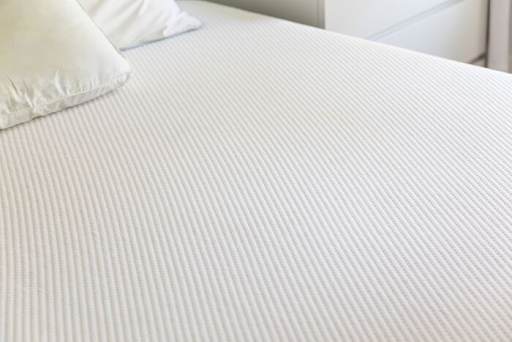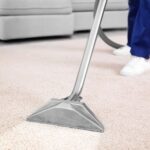We often overlook the importance of a mattress – yet we spend around a third of our lives depending on it for a good night’s sleep. A mattress may be tucked away, hidden under the bed sheets, but that doesn’t mean to say it should be forgotten about!
Every night, we shed dead skin cells and body moisture, which can all end up in a mattress. Dust mites are also at home in a mattress, with the average bed hosting an estimated 10,000 of these allergy-triggering critters. Other nuisance insects such as fleas and bed bugs, as well as harmful bacteria and viruses, can all happily infiltrate a mattress – affecting your health, potentially disrupting the quality of your slumber and making a mattress unclean.
Stains from bodily fluids and drink spills can also make a mattress look dirty and even smelly.
With all of this in mind, keeping your mattress clean and fresh is essential, especially if you want to get the recommended 8-10 years out of it.
1. What you can do
There are lots of easy ways to make sure your mattress stays as clean and fresh as possible, so get into the habit of giving your mattress the regular attention it deserves.
2. Air the mattress
With the average adult losing around 285ml of fluid every night, a mattress can quickly become damp, stale and musty. Airing a mattress daily can be one of the most effective solutions for drying out this moisture, keeping it fresh, without too much effort involved. Importantly, if moisture accumulates in a mattress, it could encourage mould or mildew to form.
Don’t be too quick to make the bed in the morning. Instead, throw the sheets back for at least half an hour, exposing the mattress to the air. Open the window to improve ventilation and allow the mattress to thoroughly dry out before tucking the sheets back in.
3. Expose your mattress to sunlight
Although exposure to sunlight can often be damaging to some fabrics and furnishings in the home, such as carpets, causing discoloration, this isn’t the case with mattresses. In fact, exposing a mattress to sunlight can be beneficial. As well as helping to dry it, the sun’s UV rays act as a natural disinfectant, killing bugs, bacteria and odours in a mattress.
Therefore, on a sunny day, expose your mattress to the sunlight, either in-situ in the bedroom, or, if you can, take it outdoors and leave it in a dry and clean spot for around six hours.
4. Vacuum the mattress
Dust, dander and dirt can accumulate in a mattress, so vacuuming it regularly is important. Every time you change the sheets on the bed, vacuum the mattress at the same time. If this isn’t always possible, aim to hoover the mattress at least once per month.
Clean the vacuum upholstery or crevice attachment first, to remove any remnants of dust and dirt. Then, use this to vacuum the mattress, paying attention to clean all of the folds, seams, nooks and crannies.
As well as vacuuming the top of the mattress, clean the sides of it, and turn it over to clean the underside. You should also vacuum the base of the bed so the mattress has a clean surface to lie on, as well as the rest of the bed frame and under the bed.
About every six to eight weeks, rotate the mattress to keep it in good condition and allow for even distribution of the mattress fillings. If you have a two-sided mattress, turn it over every so often.
5. Remove odours
Mattresses that smell a bit whiffy can be refreshed to smell more appealing with a natural fragrance, using a few simple home remedy hacks. Head to your kitchen cupboard and fetch the baking soda. Sprinkle it across the mattress and leave for a few hours, before vacuuming it away. For an even distribution, use a flour sifter. The soda is thought to neutralise and absorb any nasty odours, keeping a mattress smelling fresh. Adding cornstarch to the baking soda can also help to repel moisture from the mattress.
To enhance the natural fragrance of your mattress, you can also put a few drops of essential oil into the baking soda mix, such as lavender, which is said to aid relaxation and a good night’s sleep.
For an even easier solution to keep a mattress smelling fresh, you could place a few dryer sheets between the mattress and the bedding.
Furthermore, vinegar has properties that can neutralise odours, so this can be used as an alternative to baking soda to keep a mattress fresh. Simply mix distilled white vinegar with equal parts water, pour into a spray bottle and gently mist over the mattress, being careful not to saturate it. The mattress should be allowed to dry completely, ideally for up to 24 hours.
When freshening a mattress, it’s essential that you do both sides, so once one side has been deodorised, work on the other. You might find it easier to lean the mattress against a wall so you can access both sides.
6. Get rid of stains
Every time you change your bed sheets or vacuum the mattress, check for any stains. It’s important to remove these as soon as you spot them, to prevent them permanently marking the mattress.
Different types of stains can often be successfully removed in various ways. For example, blood can be lifted from a mattress using a mix of baking soda and water. Urine and sweat can be eliminated with a solution made fromf diluted washing up liquid and water, and a mix of baking soda and water can help to shift food and drink stains from a mattress.
When removing mattress stains, be mindful not to get the mattress too wet. This can encourage mould or mildew to set in, and may even invalidate a warranty if your mattress is still covered by one.
7. Clean sheets
There’s no point in keeping a mattress clean and fresh if you don’t give your bedding the same amount of cleaning attention. Aim to change the bed sheets every week, and when you wash them, put them on the hottest setting, according to the instructions on their label. This will help to kill off bacteria, dust mites and odours that might otherwise transfer to your mattress. Pillowcases may need washing more frequently than bed sheets, especially if you suffer from skin problems. Pillows should be washed approximately 2-4 times per year.
Adding a mattress protector can be a good investment to help keep stains, odours and moisture from the mattress. However, a mattress will still need refreshing and looking after, to keep it in the best condition, for as many years as possible.
8. Professional cleaning
Mattresses vary, so it’s always important to check the manufacturer’s instructions whenever you attempt to clean them. Otherwise, you could run the risk of causing damage to the mattress, or not removing stains or other substances as effectively as possible.
For this reason, one of the most sensible ways to keep your mattresses fresh without the risk of improper cleaning or causing them harm is to use a professional mattress cleaning company, around every six months or so. For example, at Carpet Bright UK – our fully insured mattress cleaning London company – we’ve cleaned thousands of mattresses over the years so have extensive skills and experience in this area.
We understand how to clean different types of mattresses and the correct methods and treatments to use to tackle things like mattress odours, stains, dust mites, etc. We clean and dry mattresses thoroughly, so they stay looking fresh for as long as possible.
For a free consultation, speak to our professional mattress cleaning London team today.







